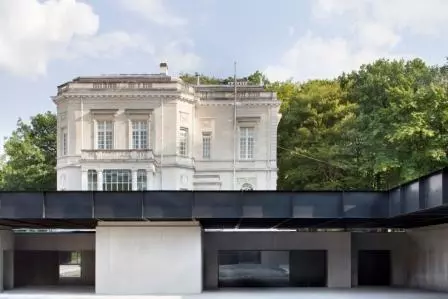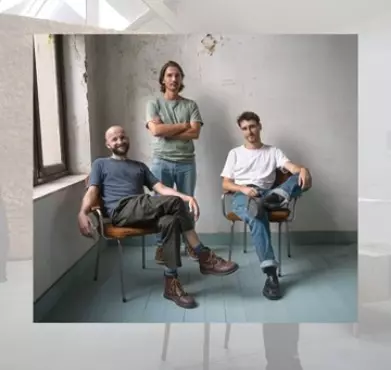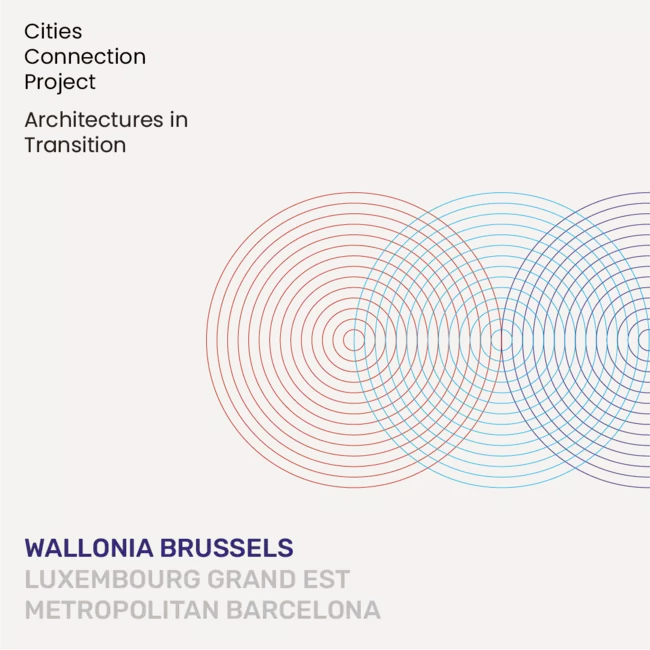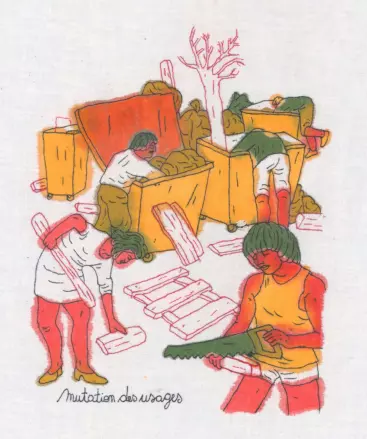- postsSite Internet
Published on 19/10/2015
entrer: Baukunst - "Embracing contradictions"
Image CopyrightMaxime Delvaux
CopyrightMaxime DelvauxIn Spa, Baukunst upturned the base instructions to reorganize the whole sports centre of La Fraineuse: instead of pavilions scattered across the site, they preferred to reorganize the flows, highlighting what already existed and concentrating the architectural intervention in a single new building creating an aesthetic dialogue simultaneous with the great modern masters and eighteenth-century Versailles.
Your lungs burn. Vapour rises from your brow and neck as sweat steams in the cold woodland air. Your body tiring, you turn towards the grand house and its invisible twin to collect your time from the adjudicator's cylindrical office.
This is the project of Brussels-based practice Baukunst. It is a lowslung square pressed into a slope, connecting underground to a refurbished manor house – in fact a twentieth-century pastiche of Ange-Jacques Gabriel's Petit Trianon at Versailles. Together the enigmatic pair provide administrative and visitor facilities for La Fraineuse, an elite sports centre surrounded by forest at Spa, Belgium.
Architect Adrien Verschuere and his team won the project through an invited competition in 2008 and though they have completed work elsewhere since, this is their first real building. Baukunst worked across the site on landscaping, traffic flow, demolitions and restoration but their new visitor centre is the key node connecting all the pieces.
Allusions to Mies van der Rohe are so overt that they do not need to be spelled out – it is as if the architects had purloined a piece of the Neue Nationalgalerie roof in Berlin and shipped it to Spa. But although the centre speaks with a Miesian language of Universal Space, instead of mechanically adaptable volumes, its rooms are highly specific, wrought from specially developed insulated concrete cast on site with 60 cm thick walls.
However, this project should not be read as yet another instance of that move so often deployed by contemporary Western architects in the presence of an older building, which is to simply juxtapose overtly modern with overtly non-modern, lazily using architectural contrast as a substitute for conversation. The intentions here are far more ambitious.
Previously the house was marooned in an asphalt pool of car parking. It lent a sense of faux classical grandeur to an athletics track in front but felt isolated. Baukunst's intervention establishes a clear territory surrounding the house with a gravel-strewn plinth upon which the fake chateau is anchored. The next-door visitor centre then inverts this arrangement with solid becoming void and vice versa. The new roof overhangs an area comparable in scale to the plinth while in the middle, instead of a building pushing up, an opening pushes down into a sunken courtyard. Figure becomes ground – it is as if the architects have constructed an antimatter sibling for the chateau whose presence can be felt through its absence.
Great designs make obscure decisions seem like obvious ones, and when seen in plan Baukunst's strategy is so clear it feels inevitable. However, it is actually a significant departure from the client's original intentions. Instead of answering the stated brief for a disparate set of pavilions scattered across the site, Baukunst pitched a single building drawing together multiple functions. It was the right move – over time the sports centre had become encrusted with a jumble of unrelated buildings, but now the campus has a clear heart. And by providing multiple through routes, the architects introduce a subversive layer of porosity to the scheme. The visitor centre itself has neither front nor back – with openings on all sides it is more canopy than building, creating visual and ambulatory connections. The forest is often explored by locals out for a stroll, but the centre's management felt ambivalent about the constant presence of casual visitors and early on suggested the project could be used to discourage walkers from wandering in. Instead Baukunst proposed the exact opposite, a strategy of opening up to encourage organic movement across the campus.
This brief-bending is, in part, a feature of Belgian commissioning. Architects are encouraged, even expected, to rethink the assumptions behind a brief and propose their own solutions. Compared to the rigid schedules of accommodation embedded in most British briefs it is refreshing to see a young practice rewrite the rule book in this way to serve a more social purpose.
For Verschuere this politics with a small p is at the heart of Baukunst's praxis. 'I don't believe in architecture for architecture's sake', he insists, dismissing designers who strive only to produce slick buildings. 'Architecture should be a device for other means. Our work is about building new relationships between people, things and the way they exist.'
All this might seem schizophrenic. On the one hand, the visitor centre is extremely stylish, elegantly proportioned and cleverly detailed (the architects have designed-out columns), holding simultaneous aesthetic conversations with the modern masters and with eighteenth-century Versailles. On the other, the building rejects cosmetic frivolity in favour of pure pragmatism: a logical reaction to its context, which subverts a limited brief to provide an armature for a more public-spirited programme.
Verschuere embraces contradictions, choosing to distance himself from traditional Belgian and architectural identities. He was born in Brussels but practised exclusively abroad before setting up Baukunst. He enters only Belgian competitions but employs only non-Belgian staff. He teaches in an architecture school but in the Walloon city of Tournai, staying detached from the Brussels architectural scene. This professional and social separation enables him to dodge the trappings which can arise from being seen as a Walloon or a Fleming, but it also equips him with the healthy naivety of an outsider's perspective. ‘I am like a foreigner in my own country.'
In sport as in architecture we often focus on the star athlete, forgetting the vast supporting ensemble of coaches, managers and physiotherapists. True to subversive form, Baukunst wants to change this. They hope that when the building is published a full list of everyone who has influenced it from lawyers and politicians to subcontractors can be included. 'One person can destroy a project', Verschuere says. 'We must respect everyone's contribution.'Written by Phineas Harper within the framework of the publication entrer: which completes the eponym exhibition. In bookshop from November 5th.
- actionsDate de l'événement
5/12/2024Published on 28/10/2024
-
A vos agendas ! Cities Connection Project #7 à Bruxelles
Nous avons le plaisir de vous convier au vernissage de l’exposition Cities Connection Project qui aura lieu le 5 décembre 2024 à 20h30 à la Faculté d [...]
- actionsDate de l'événement
20 - 30/11/2024Published on 28/10/2024
-
Inventaires#4 à Paris
Nous avons le plaisir de vous inviter à la présentation de l'ouvrage Architectures Wallonie-Bruxelles Inventaires #4, Vers une démarche architecturale [...]




